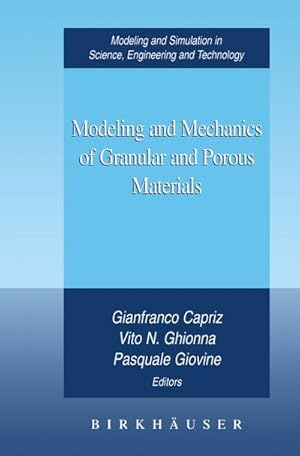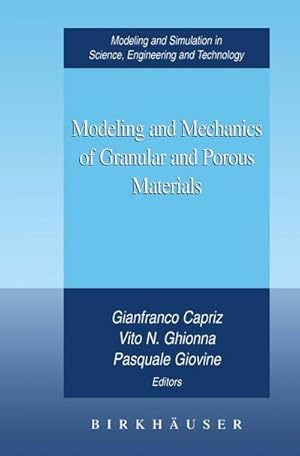modeling mechanics granular porous von capriz gianfranco (5 Ergebnisse)
Suchfilter
Produktart
- Alle Product Types
- Bücher (5)
- Magazine & Zeitschriften (Keine weiteren Ergebnisse entsprechen dieser Verfeinerung)
- Comics (Keine weiteren Ergebnisse entsprechen dieser Verfeinerung)
- Noten (Keine weiteren Ergebnisse entsprechen dieser Verfeinerung)
- Kunst, Grafik & Poster (Keine weiteren Ergebnisse entsprechen dieser Verfeinerung)
- Fotografien (Keine weiteren Ergebnisse entsprechen dieser Verfeinerung)
- Karten (Keine weiteren Ergebnisse entsprechen dieser Verfeinerung)
- Manuskripte & Papierantiquitäten (Keine weiteren Ergebnisse entsprechen dieser Verfeinerung)
Zustand Mehr dazu
- Neu (3)
- Wie Neu, Sehr Gut oder Gut Bis Sehr Gut (Keine weiteren Ergebnisse entsprechen dieser Verfeinerung)
- Gut oder Befriedigend (1)
- Ausreichend oder Schlecht (Keine weiteren Ergebnisse entsprechen dieser Verfeinerung)
- Wie beschrieben (1)
Einband
Weitere Eigenschaften
- Erstausgabe (Keine weiteren Ergebnisse entsprechen dieser Verfeinerung)
- Signiert (Keine weiteren Ergebnisse entsprechen dieser Verfeinerung)
- Schutzumschlag (Keine weiteren Ergebnisse entsprechen dieser Verfeinerung)
- Angebotsfoto (4)
Sprache (1)
Preis
- Beliebiger Preis
- Weniger als EUR 20 (Keine weiteren Ergebnisse entsprechen dieser Verfeinerung)
- EUR 20 bis EUR 45
- Mehr als EUR 45
Gratisversand
- Kostenloser Versand nach USA (Keine weiteren Ergebnisse entsprechen dieser Verfeinerung)
Land des Verkäufers
Verkäuferbewertung
-
Modeling and Mechanics of Granular and Porous Material.
Anbieter: Universitätsbuchhandlung Herta Hold GmbH, Berlin, Deutschland
2002th ed. 16 x 23 cm. 382 pages. Hardcover. Versand aus Deutschland / We dispatch from Germany via Air Mail. Einband bestoßen, daher Mängelexemplar gestempelt, sonst sehr guter Zustand. Imperfect copy due to slightly bumped cover, apart from this in very good condition. Stamped. Sprache: Englisch.
-
Modeling and Mechanics of Granular and Porous Material
Anbieter: Salish Sea Books, Bellingham, WA, USA
Hardcover. Zustand: Very Good. 0817642412 Very Good++; Hardcover; 2002, Birkhuser Boston Publishing; Very light wear to covers with "straight" edge-corners; Pages clean & unmarked; Tight binding with straight spine; Gray and light blue covers with title in white lettering; 384 pages; "Modeling and Mechanics of Granular and Porous Material," by Gianfranco Capriz, et al.
-
Taschenbuch. Zustand: Neu. Modeling and Mechanics of Granular and Porous Materials | Gianfranco Capriz (u. a.) | Taschenbuch | xiii | Englisch | 2012 | Birkhäuser | EAN 9781461266037 | Verantwortliche Person für die EU: Springer Basel AG in Springer Science + Business Media, Heidelberger Platz 3, 14197 Berlin, juergen[dot]hartmann[at]springer[dot]com | Anbieter: preigu.
-
Modeling and Mechanics of Granular and Porous Materials
Verlag: Birkhäuser Boston, Birkhäuser Boston, 2012
ISBN 10: 1461266033 ISBN 13: 9781461266037
Sprache: Englisch
Anbieter: AHA-BUCH GmbH, Einbeck, Deutschland
Taschenbuch. Zustand: Neu. Druck auf Anfrage Neuware - Printed after ordering - Soils are complex materials: they have a particulate structure and fluids can seep through pores, mechanically interacting with the solid skeleton. Moreover, at a microscopic level, the behaviour of the solid skeleton is highly unstable. External loadings are in fact taken by grain chains which are continuously destroyed and rebuilt. Many issues of modeling, even of the physical details of the phenomena, remain open, even obscure; de Gennes listed them not long ago in a critical review. However, despite physical complexities, soil mechanics has developed on the assumption that a soil can be seen as a continuum, or better yet as a medium obtained by the superposition of two and sometimes three con and the other fluids, which occupy the same portion of tinua, one solid space. Furthermore, relatively simple and robust constitutive laws were adopted to describe the stress-strain behaviour and the interaction between the solid and the fluid continua. The contrast between the intrinsic nature of soil and the simplistic engi neering approach is self-evident. When trying to describe more and more sophisticated phenomena (static liquefaction, strain localisation, cyclic mo bility, effects of diagenesis and weathering, . ), the nalve description of soil must be abandoned or, at least, improved. Higher order continua, incrementally non-linear laws, micromechanical considerations must be taken into account. A new world was opened, where basic mathematical questions (such as the choice of the best tools to model phenomena and the proof of the well-posedness of the consequent problems) could be addressed.
-
Modeling and Mechanics of Granular and Porous Materials
Anbieter: AHA-BUCH GmbH, Einbeck, Deutschland
Buch. Zustand: Neu. Druck auf Anfrage Neuware - Printed after ordering - Soils are complex materials: they have a particulate structure and fluids can seep through pores, mechanically interacting with the solid skeleton. Moreover, at a microscopic level, the behaviour of the solid skeleton is highly unstable. External loadings are in fact taken by grain chains which are continuously destroyed and rebuilt. Many issues of modeling, even of the physical details of the phenomena, remain open, even obscure; de Gennes listed them not long ago in a critical review. However, despite physical complexities, soil mechanics has developed on the assumption that a soil can be seen as a continuum, or better yet as a medium obtained by the superposition of two and sometimes three con and the other fluids, which occupy the same portion of tinua, one solid space. Furthermore, relatively simple and robust constitutive laws were adopted to describe the stress-strain behaviour and the interaction between the solid and the fluid continua. The contrast between the intrinsic nature of soil and the simplistic engi neering approach is self-evident. When trying to describe more and more sophisticated phenomena (static liquefaction, strain localisation, cyclic mo bility, effects of diagenesis and weathering, . ), the nalve description of soil must be abandoned or, at least, improved. Higher order continua, incrementally non-linear laws, micromechanical considerations must be taken into account. A new world was opened, where basic mathematical questions (such as the choice of the best tools to model phenomena and the proof of the well-posedness of the consequent problems) could be addressed.






